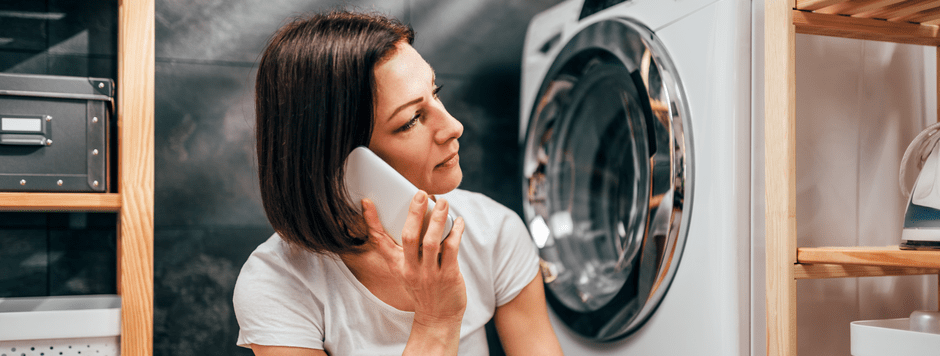Dryer not heating up? Here’s how to fix it.
Common causes when your dryer is not heating up, and how to fix them

Key tips to remember
- Make sure you know how to maintain your clothes dryer
- Is it plugged in? Is there power to the circuit it’s on?
- Is the door closed and fully latched?
- Is the setting correct for what you’re drying?
- Look into whether a home warranty covers your washer and dryer
If your dryer is giving you trouble, we have some suggestions that might help you figure things out without a service call and before you start searching online for things like “dryer not getting hot” or “dryer not heating up.” If you’re wondering what causes a dryer to stop heating and have already investigated what to do when your dryer won’t spin, and it still won’t work, you have a right to be frustrated. We rely on these machines regularly, and we’ve all had a bout with screaming, “Why is my dryer not getting hot?” toward the ceiling in an angry tirade from time to time. Don’t beat yourself up about it. Instead, put a determined effort into getting to the bottom of this nuisance. After all, struggling with frustration over a clothes dryer not heating, a gas dryer not heating or an electric dryer not heating is not the end of the world. You can often remedy this inconvenience faster than you think.
No gas or power
So, you’re no doubt wondering, “Why did my dryer stop heating?” as your toe taps impatiently and you feel the tension slowly crawling up your spine. You were counting on wearing that sweater today, and your outfit really isn’t going to work without it. We feel your pain, and we’re here to help. Let’s start with the basics. Is your dryer plugged in? Can you confirm that the power circuit it’s on has power by testing other devices within the same zone? Is the dryer door shut securely when you try to start a cycle? Do you have the machine set correctly for the items you’re attempting to dry? If your dryer uses gas, did you pay the gas bill and verify that the gas is on and connected properly? If your dryer uses electricity, are both 120-volt lines connected? If the answer to all of these questions is yes, and your dryer spins but fails to dry your clothes, you know it’s not a power or gas issue. It’s a heat-production issue.
Lint clogs
If your dryer spins but fails to heat, lint is often the culprit. Lint can gum up the works in various places inside and outside the dryer, restricting airflow, which can lead to wet clothes — even after it completes a full cycle. To target and remove all lint clogs, first unplug the machine. Then begin with the lint screen. Clear it out, and if it’s extra dirty, scrub it in the sink with warm water, a little dish soap and a toothbrush, if necessary. Once it’s dry, put it back in place. Remove any excess lint you see around the screen or in the area where it connects. Next, remove the rear panel of the dryer and use a vacuum attachment to remove any extraneous lint. Make sure you also check the entirety of the exhaust vent to verify it’s free of lint obstructions, which can not only impede dryer performance but also start fires.
Blown thermal fuse
If your dryer and its vent, screen and innards are all clear of lint clogs or other obstructions, and it still spins yet fails to heat your clothes enough to dry them, you may have blown a thermal fuse. This safety device prevents temperatures from getting hot enough to become a fire hazard. You can replace the thermal fuse, typically found close to the exhaust vent. It might be an easy replacement but could mask a more serious issue.
Tripped breaker
Much like a thermal fuse, a circuit breaker is a safety device designed to limit power when there is a risk of too much heat, electrical problems or other risks that could prove dangerous. Electric dryers use two breakers, one for power and one for heat, so it’s necessary to check both at your electrical panel. When you reset the breakers, as when you replace a thermal fuse, remember that there is a cause for the system limiting itself. If it’s not a lint clog, it could be something more significant.
Bad flame sensor (gas models)
Much like a pilot light on a gas fireplace or a gas water heater, gas-powered clothes dryers require a flame to ignite the gas that will create the heat. A flame sensor, if faulty, will no longer allow a flame to ignite. They’re not difficult to replace. Typically located outside the flame igniter in a small black box below the spinning dryer drum, you can test a flame sensor by using an electric multimeter to measure its resistance. After using the multimeter, if you conclude that the flame sensor has gone bad, go ahead and replace it. Don’t forget to restore power and reopen the gas valve after completing the flame sensor replacement.
Bad timer
Some dryers still run on mechanical timers, which tend to prevent the dryer from moving along from cycle to cycle when they go bad. This stuck sequence can result in overheating, leading to tripped breakers or blown fuses. It could also result in the dryer not releasing heat. After powering down the system and turning off the gas (if you have a gas model), you can find the timer motor and attempt a continuity test by removing the knob and opening the front top panel. After discontinuing the power leads from the motor, check for continuity with the multimeter. If your meter displays the infinity symbol, it’s time for a new timer motor.
Bad heating element or coils
Sometimes a bad heating element can cause a lack of heat in the dryer due to blocked coils, which causes the element to overheat. With the power (and gas, if applicable) disconnected as always, remove the panel on the back of the dryer to access the element and its coils. Use that multimeter to test the heating element and coils for continuity, and replace the element if it fails the test. Reconnect all the wires you disconnected, replace the removed panels, power (and gas) up as necessary, and you should be good to go.
Bad thermostat or temperature switch
You can find the thermostat or temperature switch near the heating element on most dryers. These parts maintain a consistent temperature during each cycle. Problems in either can result in blown fuses, tripped breakers and a loss of heat. They can also simply force the machine to power down. You can test them with a multimeter, much like the other parts we’ve described. If you determine that either or both parts need to be replaced, a temperature switch is by far the easiest of the two. Putting in a new thermostat requires several more steps that must be completed in the right sequence. But if you’re determined and careful, you can do this.
Unbalanced load
Here’s a problem that everyone experiences from time to time. If it gets bad enough, it can result in a wadded-up mess of wet clothes that doesn’t do anyone any good. The main way to avoid an unbalanced load is by drying items of a similar thickness and weight together, like a load full of towels, as opposed to including the sheets in the same load. When fabrics have widely differing weights, unbalancing is more likely.
Clothes still wet?
Have you tried all of these suggestions and more, including these quick fixes to get your dry on, and are still asking yourself, “Why isn’t my dryer getting hot?” We’re sorry to say that it’s probably time for a service visit from a professional. They can help you get to the bottom of the problem and advise on whether you need to pay for a fix or go ahead and replace your dryer. After fixing or replacing your dryer, you may also want to consider covering it with a home warranty. Remember, you should have your major appliances serviced at least once a year, especially because dryers are the most common cause for house fires. You want to keep yours running safely, efficiently and effectively all year long.
The information in this article is intended to provide guidance on the proper maintenance and care of systems and appliances in the home. Not all of the topics mentioned are covered by our home warranty or maintenance plans. Please review your home warranty contract carefully to understand your coverage.
